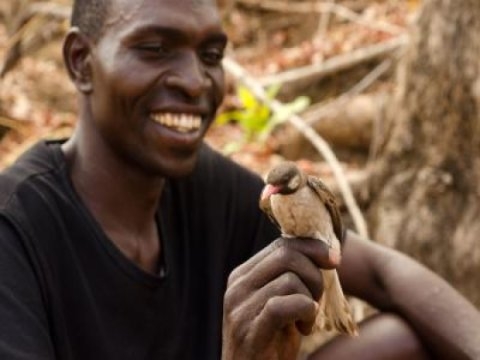- Home
- >
- The communication between hummingbirds and humans is a two-way process
The wonders of nature are truly fascinating. When humans speak, a bird species known as the Greater Honeyguide in Africa listens and understands, then guides hunters to find the sweet liquid gold.
The Greater Honeyguide is known for its unique ability to communicate and cooperate with humans in search of honey. This bird has developed a special relationship with certain indigenous communities in Africa. The bird's communication with humans involves specific vocalizations, known as "trilling calls," which are used to initiate the cooperative behavior.
When hunters make specific vocalizations imitating the call of the Greater Honeyguide, the bird recognizes and responds, leading them to honey-rich locations. During this cooperative foraging, the bird guides the hunters by flying from tree to tree, sometimes even calling to maintain communication. Once the hunters reach the honeycomb, they can collect honey for themselves while leaving behind a portion for the bird as a mutual benefit.
This remarkable example of interspecies communication and cooperation showcases the intricate connections within nature. The Greater Honeyguide and human hunters have formed a unique partnership based on mutual understanding and the pursuit of a shared resource.
Indeed, the natural world is filled with extraordinary phenomena that continue to amaze and inspire us.
The Greater Honeyguide is a remarkable bird that, upon discovering a beehive, emits a call to attract honey badgers or humans to follow it and locate the honeycomb. Once the honey badger or human breaks open the hive, the Greater Honeyguide consumes the leftover honey and beeswax as a reward, resulting in a mutually beneficial behavior.
Field biologists from the University of Cambridge and the University of Cape Town discovered that the Greater Honeyguide in northern Mozambique, known as Indicator indicator, knows that when a specific trilling sound is made by a person, it indicates the desire to find beehives and the delicious honey within. Hearing this trill, the Honeyguide will guide human hunters to the hive, while enjoying the sweet honey and beeswax as a reward. This unique relationship between the bird and humans does not involve domestication or training, making it an intriguing example of interspecies communication and cooperation in the wild. This finding was published in the journal Science.
Although this is a recent scientific discovery, this human-bird relationship has likely existed for thousands or even millions of years. The Greater Honeyguide's role is to fly from treetop to treetop, guiding humans to the honeycombs, while humans employ tools like axes to retrieve the hives. This special partnership demonstrates the complementarity of human and bird abilities.
While the Greater Honeyguide possesses the skills to locate beehives, it is vulnerable to bee stings. Humans, on the other hand, can wield tools and use smoke to subdue bees, making them more adept at finding beehives. Previous studies in Tanzania and Kenya revealed that when birds assist humans, they are more successful in obtaining honey. The researchers, led by Claire Spottiswoode, aimed to determine whether the communication between humans and birds is reciprocal, recruiting Yao hunter-gatherers living in the Niassa National Reserve in Mozambique to participate in experiments. The Yao people engage in fishing and agriculture but are economically disadvantaged. Thus, wild honey supplements their caloric intake and satisfies their desire for sweet food.
With the assistance of the Greater Honeyguide, the opportunity to find beehives increased from 17% to 54%. The Yao people emitted a specific call, "brrrr-HM," which has been passed down for generations, to attract the Honeyguides. During the process of following the Honeyguide, the constant emission of this specific call increased the chance of guiding the bird by two-fold. Continuously producing the "brrrr-HM" call during the journey increased the likelihood of finding the beehive by three-fold. Under these circumstances, there was a 66% chance of attracting the Honeyguide to guide them to the hive and an 81% chance of successfully tracking down the beehive.
Different tribes may use varying calls to attract the Honeyguide. According to Brian Wood, an anthropologist from Yale University, Tanzanian hunter-gatherers employ a melodious whistle, which he believes the Tanzanian Honeyguides also recognize. It remains unclear how the Honeyguides learn to identify human calls, as another peculiar behavior they exhibit is brood parasitism, laying eggs in the nests of other birds. This means that the young Honeyguides do not have the opportunity to learn from their biological parents.
The time to study this behavior is limited, as this tradition may disappear due to more Africans purchasing sugar instead of relying on their avian partners. This would weaken the only connection between Honeyguides and humans. Scientists must strive to understand this unique relationship before it is too late.
Original research: Claire N. Spottiswoode, Keith S. Begg, Colleen M. Begg. Reciprocal signaling in honeyguide-human mutualism. Science, 2016 DOI: 10.1126/science.aaf4885
References:
- Elizabeth Pennisi. Unusual bird-human partnership runs even deeper than scientists thought. Science. JULY 21, 2016. DOI: 10.1126/science.aaf5859
- Sean Greene. Hunter calls. Bird responds. And together they find honey. Los Angeles Times. JULY 21, 2016.
- Traci Watson. First Proof That Wild Animals Really Can Communicate With Us. National Geographic. JULY 21, 2016.
- University of Cambridge. "How humans and wild birds collaborate to get precious resources of honey and wax." ScienceDaily, 21 July 2016.
- NATALIE ANGIER. African Tribesmen Can Talk Birds Into Helping Them Find Honey. New York Times. JULY 22, 2016.
Author: Huang Chen-Hsiang
Currently teaches at the Institute of Molecular and Cellular Biology and Department of Life Science, National Tsing Hua University, and writes popular science articles as a contributor for the Science Education Center.

